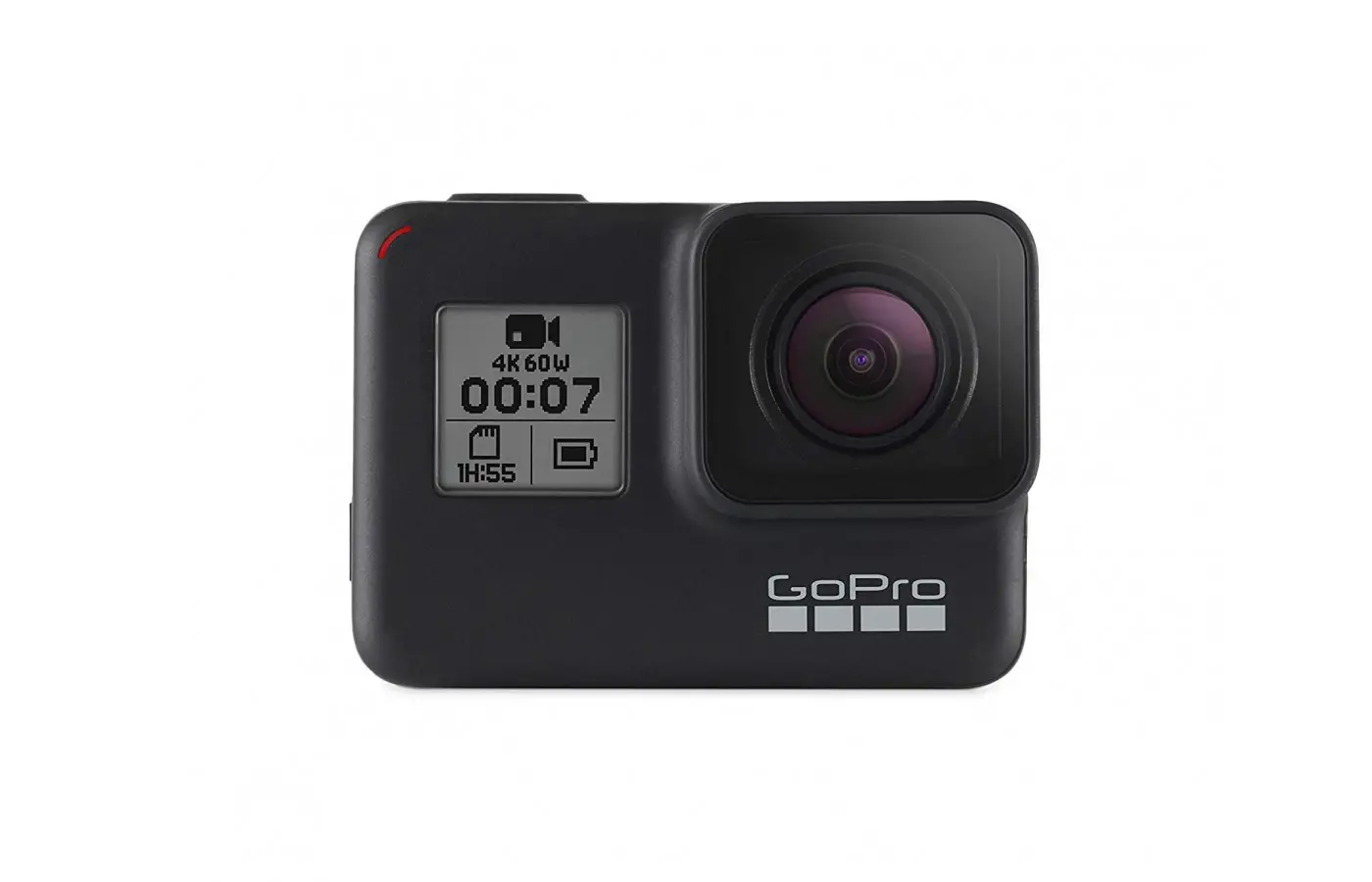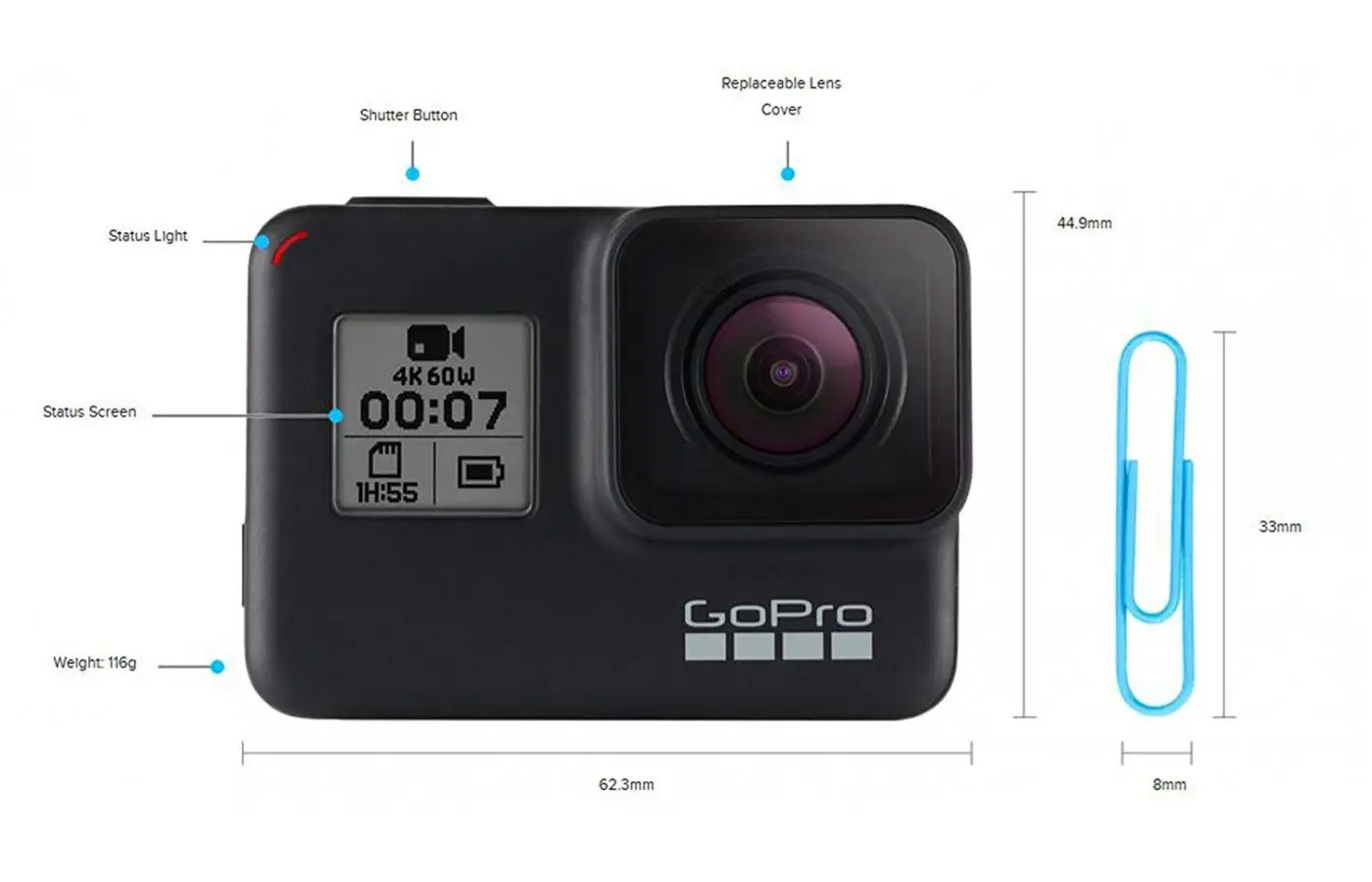GoPro Hero 7
GoPro’s new flagship star action range Hero 7 replaces the excellent 2017 Hero 6. The GoPro Hero 7 is a small step forward from Hero 6. Its range of mounts, usability, stabilization, and video quality place it on the list of best all-around action cameras.
Reviewers describe it as the best action camera on the market today. The fundamentals are the same as the Hero 6. Hero 7 is a pocketable camera that is waterproof. It leads the class in electronic image stabilization and has a broad range of mounting accessories. The camera is nearly identical physically to Hero 6.
Two significant differences are - a microphone redesigned for improved audio and a new black paint job. Several new software features include the Hypersmooth boosted image stabilization system, a fancy TimeWarp time-lapse effect, and being able to live stream videos to Facebook and other sites with a smartphone. The minor upgrades push the current GoPro design to the limits. It retains the head place at the action camera table.
- Decent stills and impressive videos
- Huge range of accessories and mount.
- Improved audio quality
- Offers live streaming
- Superb image stabilization
- Waterproof
- Can overheat when recording 4K
- Occasionally unresponsive or sluggish UI
Accessories
Settings
Some reviewers think the settings bar on the Hero 6 is a bit clearer. Using the Protune mode squeezes the most from Hero 7. It allows settings such as exposure compensation, sharpness, and ISO ranges to be tweaked.
A choice between ‘flat’ profile or GoPro color correction can be made. Footage can be graded in something like Adobe Premiere Pro afterward. Out of camera footage is fine for the non-professional who doesn’t want to edit.
When the max 4K/60fps setting is used, there are restrictions to keep in mind. The 4K recording does not have a linear field of view. Shooting is done with the ‘fisheye’ look. The Hero 7 gets very hot if extended clips are shot in this mode.
After about 35 minutes, the camera will shut down because of excessive heat. Hypersmooth should be reserved for short clips. The Hero 7 slo-mo modes are likely more useful. A lot of light is necessary for best results. Gloomier settings have an odd strobing effect. In daylight, great slo-mo footage of mountain bikers going through puddles or swimmers gliding past can be taken.
Design
There are a few other corrections made to this year’s update. The question is, ‘Are they issues that matter?’ If frustrated by shaky footage or wrangling videos to social media, the answer is, ‘Yes.’ Those hoping for new video modes will be disappointed. There is something for everyone. Another question is, ‘Can it replace a phone camera?’
Connectivity
Approximately an hour and 45 minutes of battery life are provided for continuous 1080p/30fps video, which is par for action cameras. Shooting 4K/60fps is the most restrictive. A charge provides continuous recording of only 45 minutes in this mode.
If the camera overheats, it is unusable after 35 minutes. Overheating is not uncommon. Much larger cameras have 30-minute restrictions for 4K video recording for that reason. Keep the restrictions in mind before thinking about all day Hypersmooth-stabilized 4K shooting. The Hero 7 charges from USB-C. Approximately an hour is needed to recharge. Reviewers would like to see a significant bump in battery life.
Performance
Some find it okay for the most part. Other video producers feel the touchscreen controls border on infuriating at times. Small cameras tend to present usability issues. Hero 7 is easier to use than the majority of action cameras.
There are relatively reliable hands-free voice controls such as, ‘GoPro, start recording.’ Reviewers are inclined to rely on the safety of a real button and use voice controls as a backup. Hypersmooth beats the impressive Hero 6.
It is likely the best electronic stabilization on an action camera, though not completely infallible. It nullifies the shake from handheld footage. When taken on a go-kart track ride, there was plenty of vibrations.
In that aspect, the Hypersmooth was no better than the Hero 6 stabilization system. GoPro tells us the jello-effect of a rolling shutter has been solved. Reviewers have seen no significant signs to dispute the claim. It is another bonus over earlier Hero cameras.
Standard time-lapse videos work best when a camera is static with the motion surrounding it. Footage can get a little jerky. The TimeWarp smoothness is an excellent option for sharing and capturing sped up first-person journeys such as bike rides. They will be popping up on Instagram feeds soon.
The changes in the microphone have also borne fruit. Clipped to a guitar the mids are more precise and the bass beefier. It is a reliable option for homemade YouTube videos or vlogging, especially in combination with the field of view that removes fisheye barrel distortion.
The mode is not available in the 4K recording. Dual microphones do a decent job reducing the wind noise of a bike ride. More challenging recording such as live gigs still requires an external microphone to get top-notch sound. Overall, Hero 7’s built-in audio quality is better than Hero 6.
It is not significantly better than a smartphone, but the waterproof Hero 7 can shoot from extreme places and angles. It is not perfect. The camera gets very hot when used for continuous 4K footage recording. It will automatically shut down.
The 12-megapixel photos are excellent in proper lighting, primarily if the HDR mode is used. For stills, Hero 7 is more of a smartphone backup than a rival. It is a waterproof travel camera ideal for those who do not want to lug around a bigger camera.
Getting slo-mo or usable footage in low light is a struggle. GoPro Hero 6 owners are unlikely candidates for an upgrade. Those looking for a waterproof, pocketable camera that shoots excellent videos from angles beyond more fragile and restrictive smartphones should consider the Hero 7. Hero 7 is only a small step above its predecessor, but it has an excellent range of mounts, usability, stabilization, and video quality, making it the best all-around action camera available.
Image Quality
It is not much different than the Hero 6 in color and dynamic range because the same sensor size, lens, and processor are used. The main focus was on improving video stabilization. Video quality alone is not a reason to upgrade to the Hero 7.
Footage may look a bit ‘warmer’ than the Hero 6, but it can handle conditions outdoor with the same vibrant color as the predecessor. Low indoor light is more problematic, but awesome outdoor videos during dusk results are possible.
There may not be a host of imaging improvements or new shooting modes, but a few key tweaks make it exciting for old and new users. The stability upgrade alone saves hours of possible memories from ending up in the trash can.
Features
Hypersmooth has no optical stabilization behind it. It is done electronically. Images are cropped by five percent. The benefit gives the camera wiggle room to counter vibrations or shakes sensed by the giro.
Hypersmooth differs from the Hero 6 stabilization with a bit more memory and fully harnessed the power of the GPI processor. It is a definite improvement, especially for handheld shots. The Karma Grip is smoother, but Hero 7 is not far behind
TimeWarp is a new time-lapse mode that utilizes Hero 7 boosted stabilization to shoot what is referred to as first-person ‘magic carpet ride. TimeWarp is not a new idea but is a well-executed, fun time-lapse shooting mode, new to Hero 7.
A new stills feature, SuperPhoto, acts as a sort of ‘super-auto’ mode. It changes settings based on the scene. Automatic detection of scenes, smiles, and faces are built into the camera in ‘SuperPhoto. Setting changes such as white balance happen automatically.
SuperPhoto makes the GoPro Hero 7 a robust choice for stills.GoPro’s Quik app has an automatic editing feature that picks shots for QuikStories. The redesigned microphone improves the audio. Adding live streaming is a plus. The Hero 7 can live stream with a smartphone to Facebook currently, and eventually to sites such as YouTube.
Hero 7 is the same price as its predecessor. The Hero 6 $399 price tag remains. The best GoPro camera got better without an impact on the pocket. Those who have the Hero 6 may want to think about an upgrade.
The Hero 7 is an improvement on winning formula. It is an example of why GoPro dominates the market. It is expensive and has some faults, but the company pays attention to critical areas such as high video images, video stabilization, and great fun.
Ergonomics
The worry of coming back with a memory card filled with random rucksack shots is eliminated. Combining the video options, including Protune and ’field of view’ manual controls, means it is much easier to fine-tune settings quickly and get creative.
Key Features
* Shoots 1080p/240fps; 4K/60fps video
* Slo-mo and time-lapse modes
* Still 12-megapixel photos taken with HDR
* Waterproof to ten meters
Bottom Line
Many of the features, such as 240fps slo-mo, 4K/60fps video, live streaming, and electronic image stabilization are available on smartphones. It is a minor upgrade to the discontinued Hero 6. The combination of the features mentioned above with the unmatched mounting options range and rugged, waterproof form make it an excellent addition to any photographic tool kit.
The touchscreen can be frustrating but is significantly more user-friendly when compared to most budget action cameras. For those who don't want to spend time rifling through footage, Hero 7 has handy editing options such as the GoPro Quik app.
The superb electronics image stabilization means there are more usable clips. The fully waterproof Hero 7 does not need a case, which is a bonus. The improved audio quality provided by the redesigned microphone is another.















